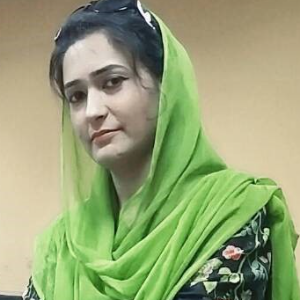Title : Green synthesis, characterization and wound healing potential of silver nanoparticles
Abstract:
Nanotechnology is the manipulation, fabrication and designing of individual atom, molecule or restructuring of matter at nano-scale range. The ultra-fined particles within 1 to 100nm diameter are termed as nanoparticles. The nano-equipments including nanoparticles, nanocapsules etc which brought innovations in almost all the fields of life. Fundamental to current research was the synthesis of AgNPs by using the leaf extracts of Acacia nilotica, due to the eco-friendly nature of plant parts, after successful synthesis these particles were characterized by UV vis spectrophotometry scanning electron microscopy and XRD. Formation of AgNPs was confirmed by observing the surface plasmon resonance peak at 424nm and determination of their wound healing potential to cure the excision wounds in male and female albino rats (300-350g), at four different doses (1000µg⁄ml,500µg⁄ml, 250µg⁄ml and 125µg⁄ml ) at three intervals within 21 days (wound measurement after 7, 14 and 21 days), keeping water as negative control and pyodine as positive control, followed by the histopathology of the animal skin. SEM images elucidated the formation of irregular shaped (spherical, triangular and platy shapes) silver nanoparticles, with the average diameter of 30-70nm. Statistical analyze results denoted that AgNPs showed effective speedy recovery of wound healing after 7days of dose application at 250µg/ml and 500µg/ml at which wound reduction in male and female rats was 79% and 64% respectively as compared to the negative control (43% and 40% in male and female rats respectively) while positive control showed 50% and 43% male and female rats respectively. After 14 days, about 70% of the wound area healed and at 21 days above 90% wound area was cured. Histopathology of cure skin revealed healed epidermal lining and granular layer appeared normal, without any degeneration, necrosis, inflammation and dermal edema at high dose of 1000µg⁄ml. The functional groups (Carbonyl group of amino acids or OH group of phenolics) present in the biomolecules of A.nilotica leave extracts might have attached to the silver particles as reducing and capping agent that may have played role to reduce the wound area. So, AgNPs proved to be potential wound healing material for normal wounds.
Audience take-away:
- This study was designed to formulate wound healing drugs based of plant extracts in order to reduce the toxic effects of chemicals and nano based drugs are preferable now a days due to having numerous benefits such as low.
- Furthermore efforts are required to formulate effective nano-drugs using waste materials from plant materials. In order to keeping in view the hazards of chemicals and cost effectiveness of drugs.



